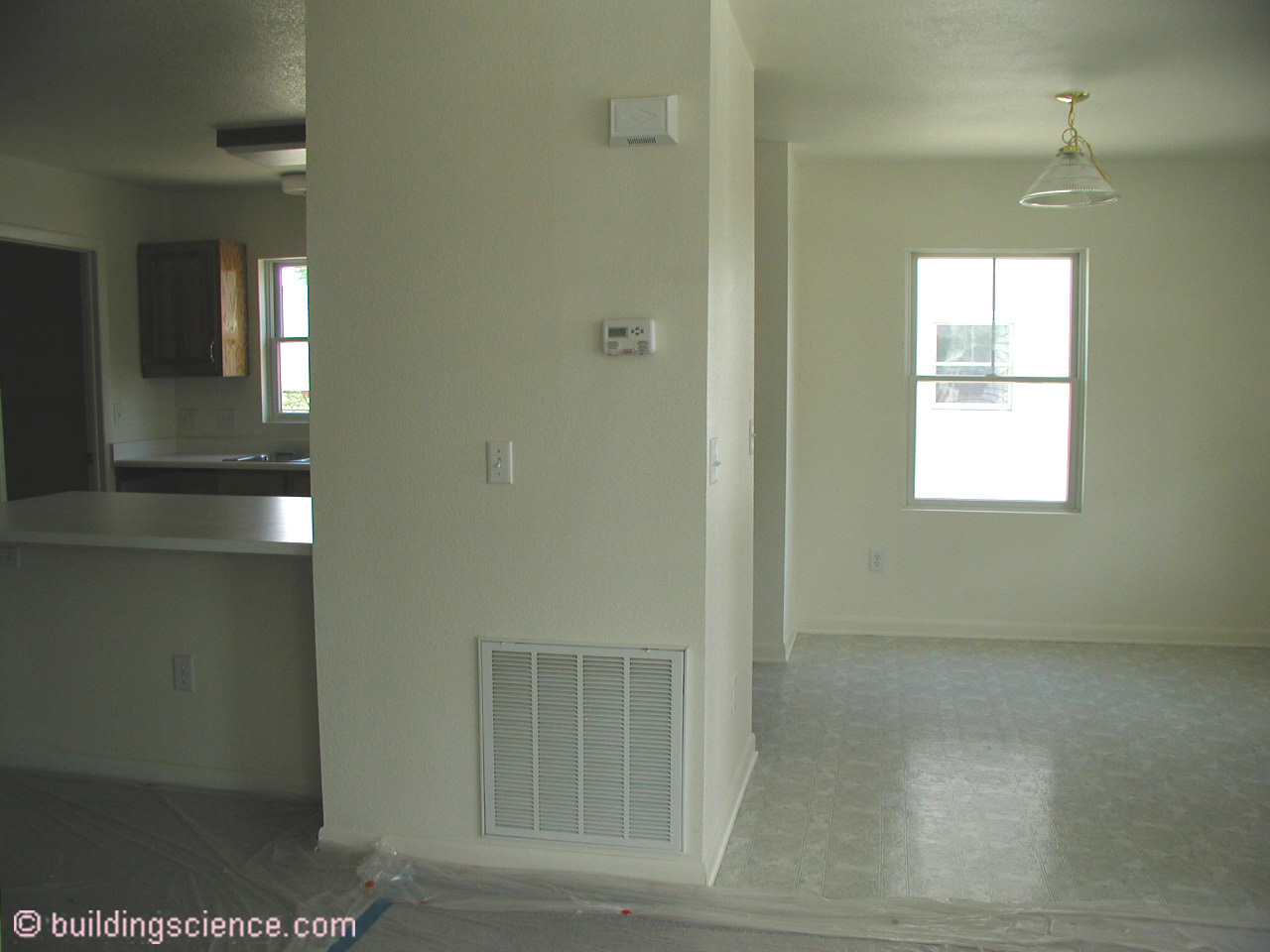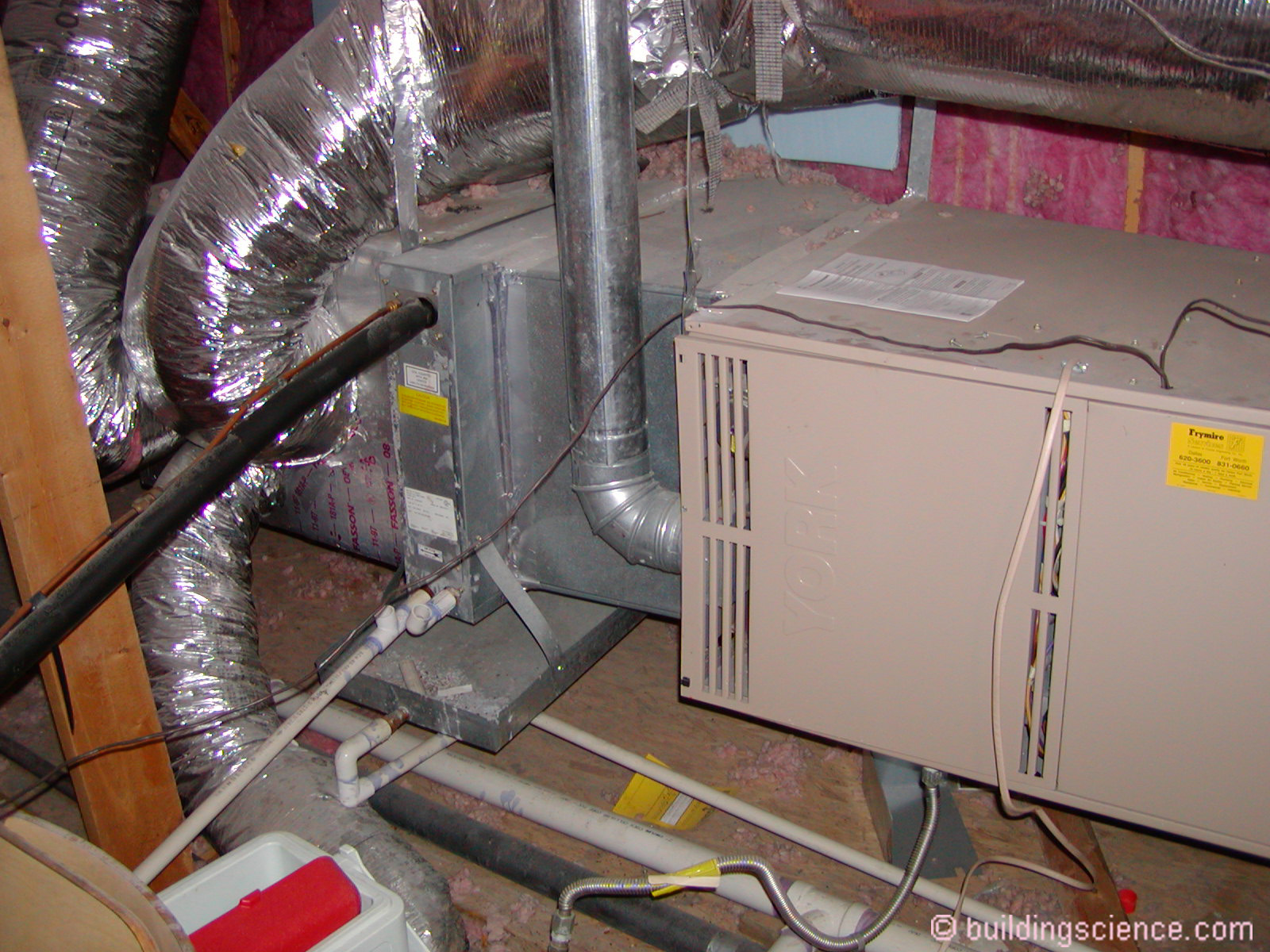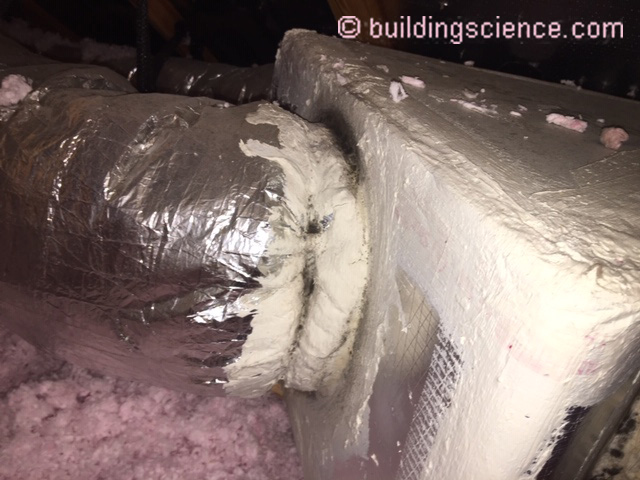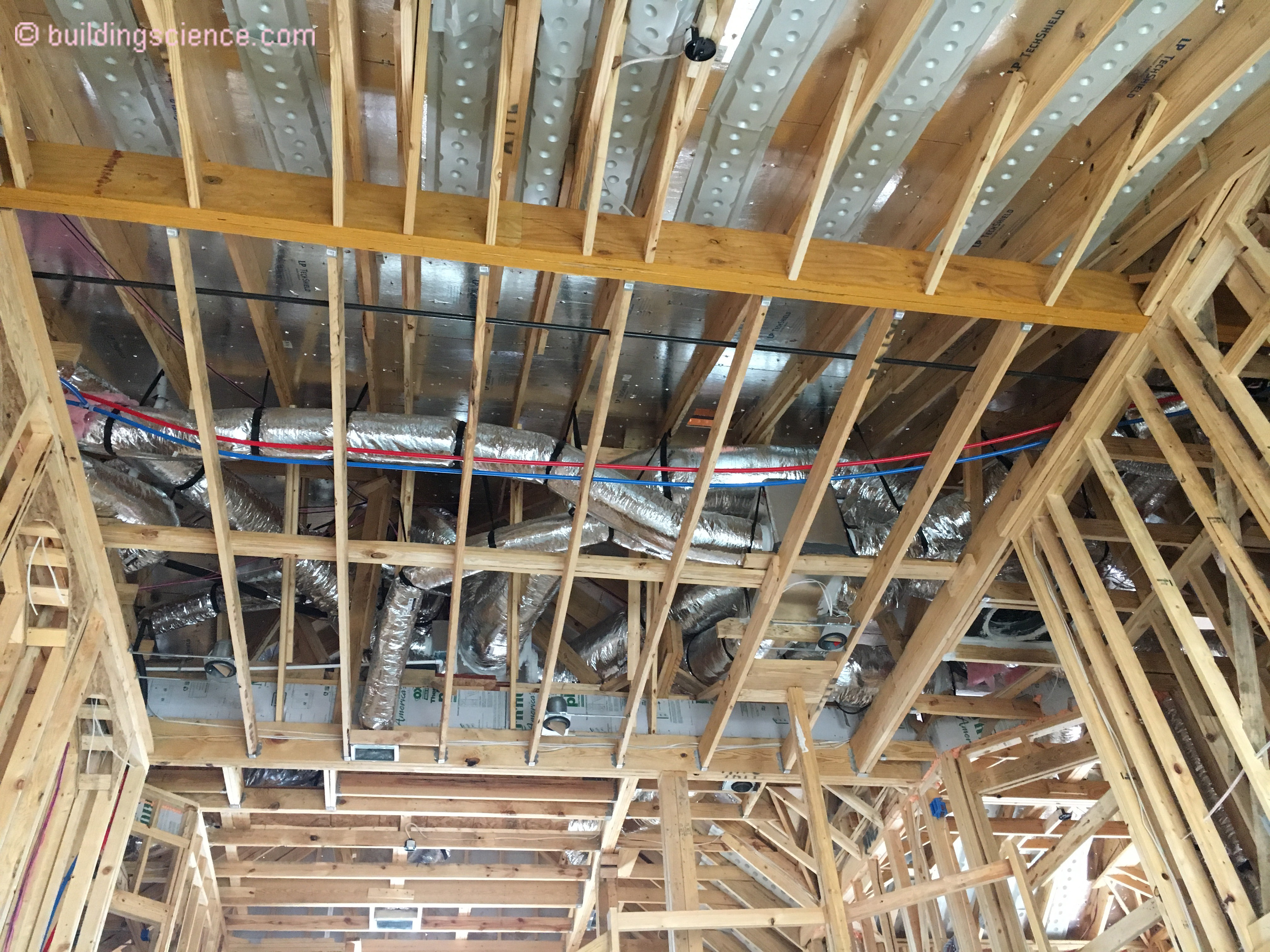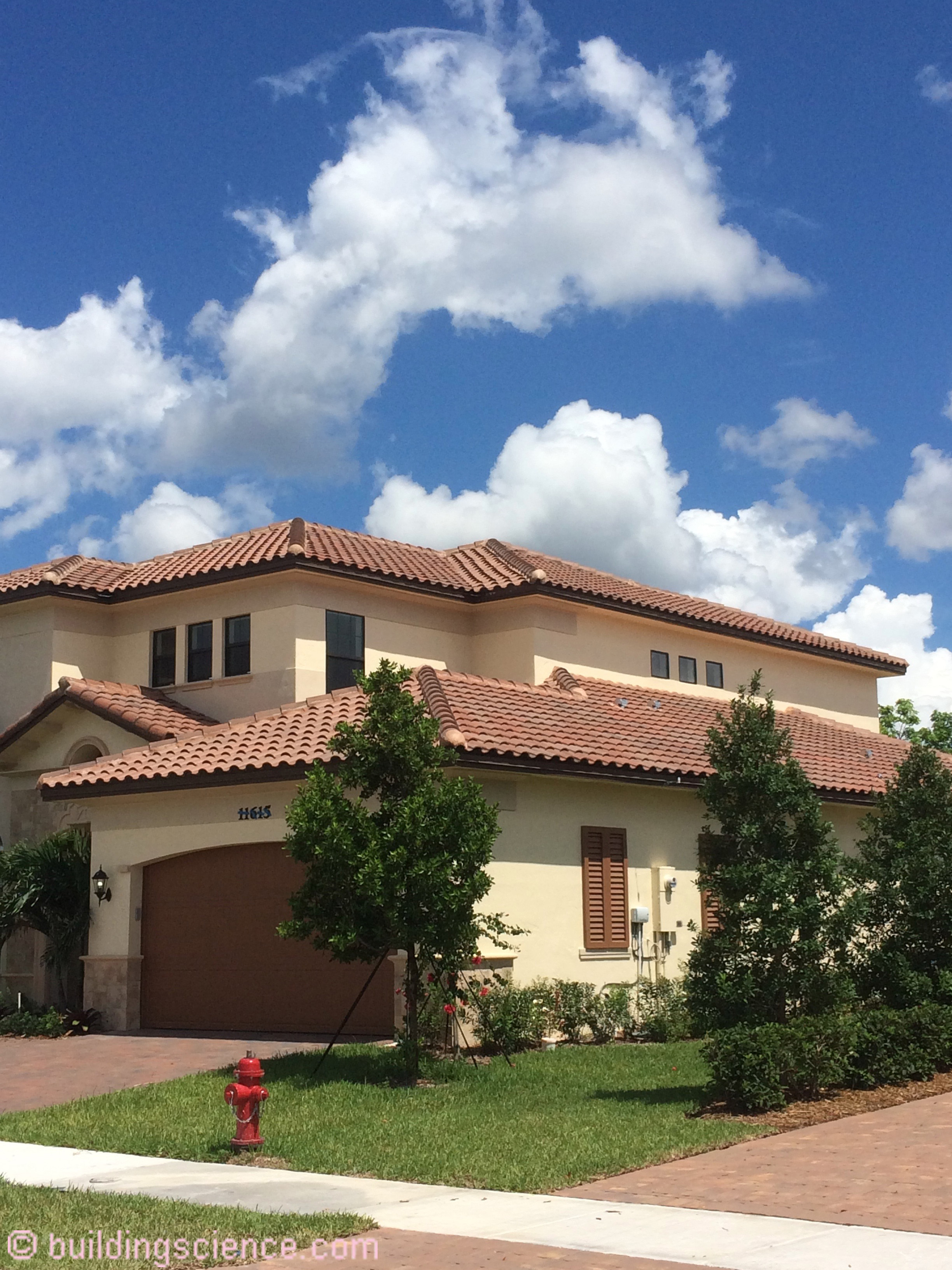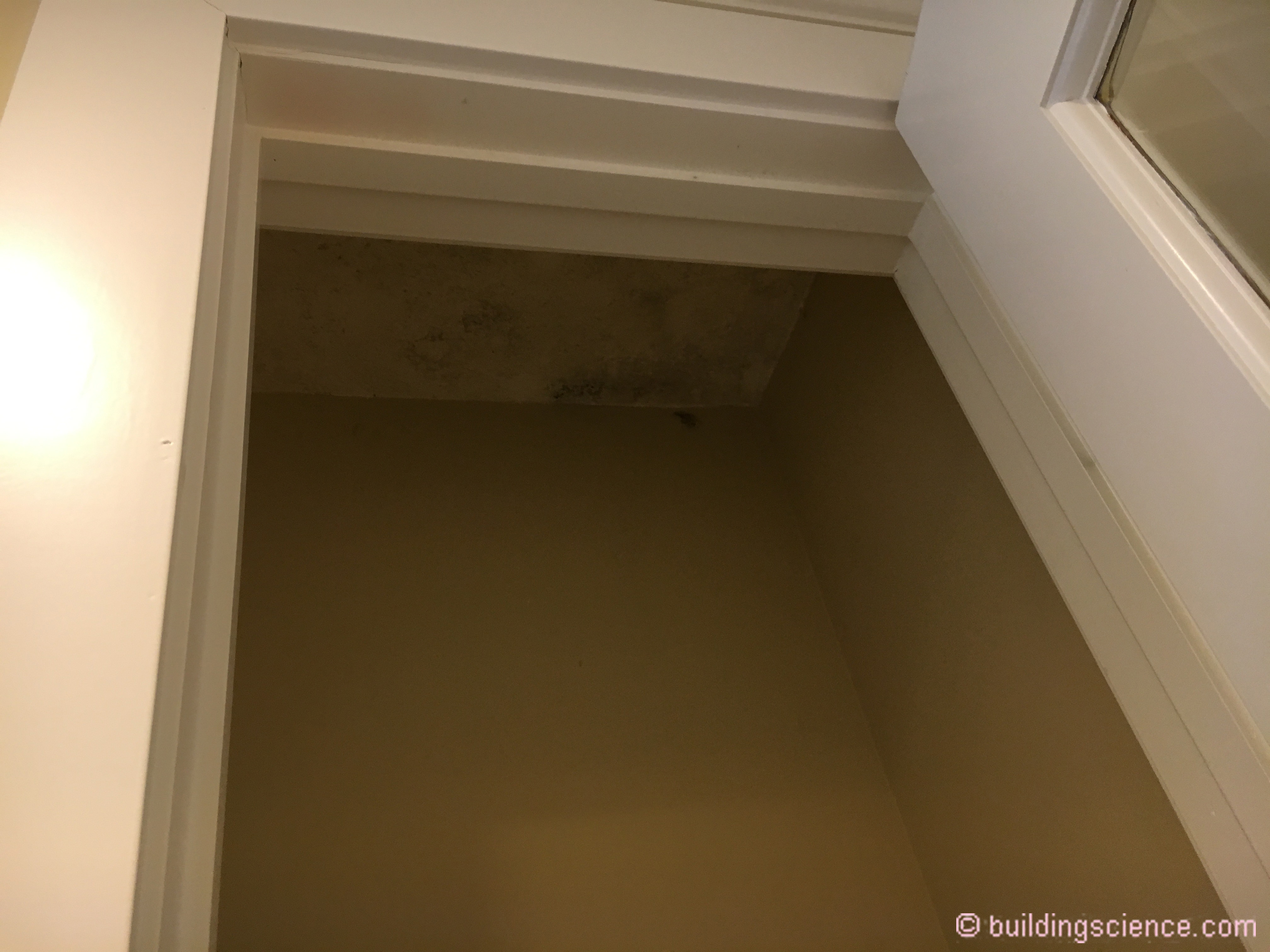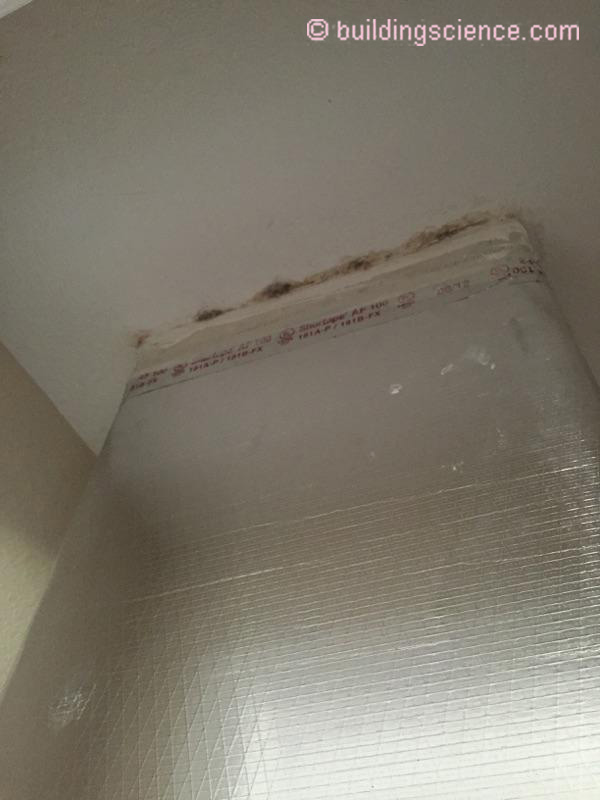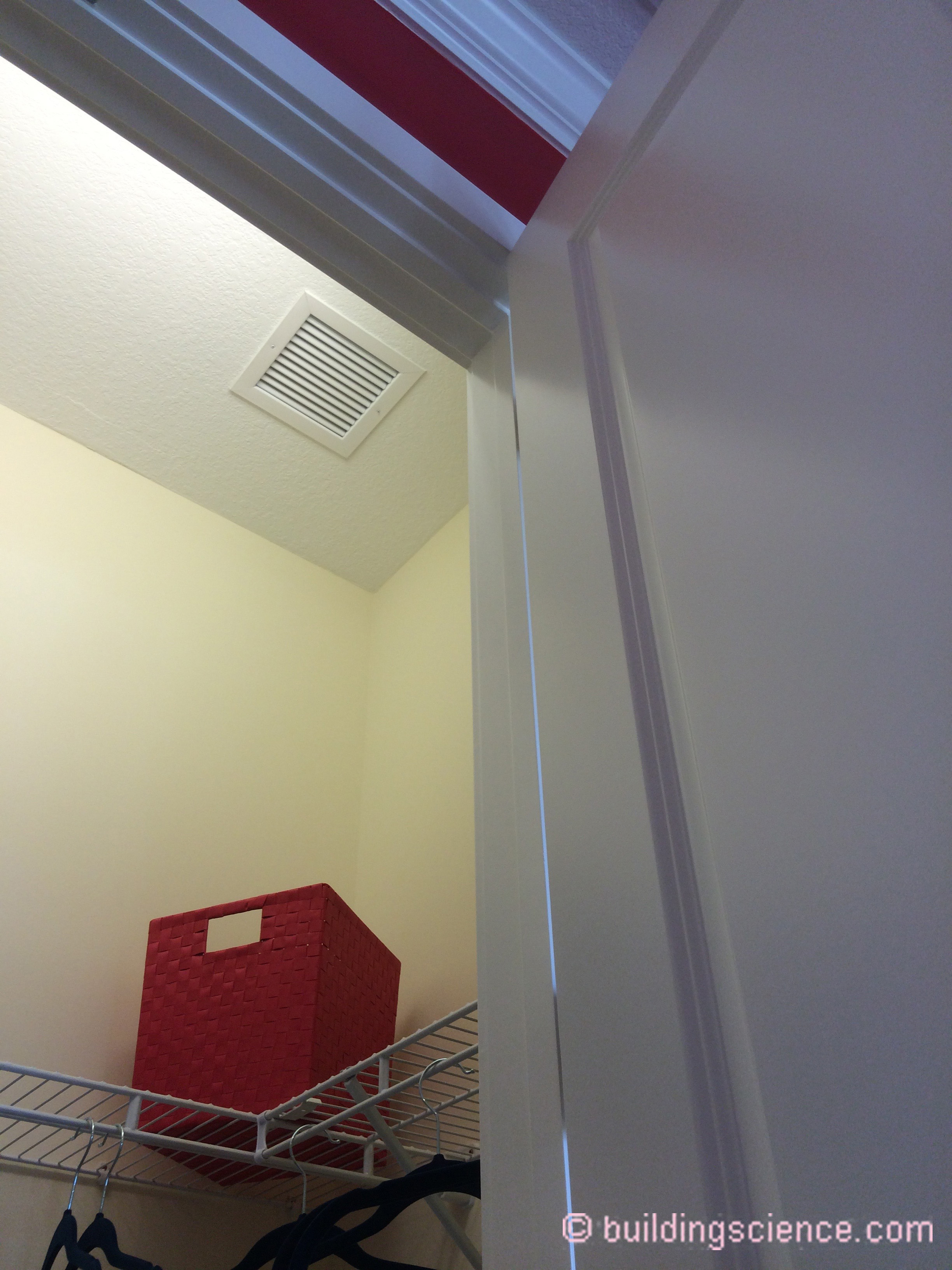Remember the good old days when we had filters right at the single central return that we could easily change (Photograph 1). We didn’t have to go to the furnace or the air conditioner. The filter was right there. Not having to go to the furnace or the air conditioner was a big deal for some folks because most furnaces and air conditioners were located in attics. Still are (Photograph 2). People who live up north forget that basements were invented so that we would have a place to stash the furnaces[1]. Down south we don’t do basements. In Texas attics are called “Texas basements”. Don’t do basements in Florida either. Hard to dig a basement when you live next to a swamp or on a sandbar surrounded by water.
Photograph 1: “Filter Grille” -Remember the good old days when we had filters right at the single central return that we could easily change. We didn’t have to go to the furnace or the air conditioner. The filter was right there.
Photograph 2: Attic Air Conditioner and Furnace –Standard vented combustion gas furnace with a single stage air conditioner located in a south Texas attic.
And we didn’t make it easy to get into the attic. Attic hatches got their name because they were “hatches”. Sometimes just a piece of plywood covered a hole hidden in a closet. And of course we never put stuff in a closet so to get to the hole in the ceiling we never had to move stuff… Servicing an air conditioner located in an attic was not a fun thing to do. So normal people…we call them civilians…did not make it a practice to go into attics. If you didn’t go into an attic you wouldn’t see what was what in an attic.
Things change. “Filter grilles” days were numbered. Civilians began to be sold on the concept of having filters that actually filtered. The “boulder catcher” filter at the return grille wasn’t up to the task. Builders began to install real filters and those real filters had to be at the air handler. The air handler was in the attic. Had to make it easy to get into the attic. Easy solution. Pull down stairs. Civilians could now easily get into the attic to change a real filter at the air handler.
Uh oh…rut roh…civilians in the attic… Yup, things were going to end badly….especially in hot humid climates like south Texas and south Florida. We vent attics there. We shouldn’t, but we do[2]. Here is how venting attics works. You deliberately bring air from the outside into the attic through things called holes. OK, we don’t call them holes. We call them vents. But they really are holes. Wait for it….the air outside in hot humid climates is hot and humid. Yup, venting attics in hot humid climates brings hot humid air into attics.
It is lucky for us that there is nothing cold in the attic that could sweat or condense hot humid air. Oops. That is where we put supply air ductwork and air conditioners. Did you know that an air conditioner is a machine that makes things cold? Like air? Air that then is distributed by ductwork…making the ductwork cold. Cold air handlers and cold ducts in vented attics in hot humid climates sweat.
They have always sweated. Everyone who is not a civilian knows this. But if you don’t go into an attic very often you don’t see the condensed water. Well, now civilians are going into attics regularly and see the sweating. Many non-civilians when confronted by the civilians are behaving like Captain Renault…“we are shocked, shocked to find condensation going on in here”.[3]
But there is more sweating. More about that later. We have to deal with something else first. We used to tape the joints of flex duct using aluminum tape. We used to tape the joints in ductboard using aluminum tape. Now we use mastic. Mastic makes for tighter ducts. We want tight ducts. We test ducts to make sure they are tight. We get tight ducts and we get them reliably because we use mastic. When flex duct sweats and gets wet it just gets wet…it doesn’t get moldy. When aluminum tape sweats and gets wet it just gets wet…it doesn’t get moldy. Mastic gets moldy. Worse. Most mastics are “white” in color so you can actually see the mold (Photograph 3). Didn’t have a problem when the mastics were dark in color.
Photograph 3: Mastic -Mold on mastic in a vented attic…a space that is outside the house. Most mastics are “white” in color so you can actually see the mold.
OMG! Mold on mastic in a vented attic…a space that is outside the house….call the CDC…we are all going to die…save the children. We are not talking Ebola here…a little bit of mold in a part of the house that is outside is not a big deal. Inside? Different story.
Then we have social media. You might have heard of the internet. A civilian goes into the attic to change a filter and sees condensation on ductwork and mold on mastic and everyone in the community knows instantly and we have a crisis. If nobody notices there is no issue….but…but…your “spidey sense” should be tingling….
Why now? Why not a couple of years ago? Why not a decade ago? Why not two decades ago? I remember going into vented attics in south Florida in the late 1980’s and noticed sweating ductwork and sweating air handlers. It was no big deal.
Ah, there is more sweating today. Much more. And we did it to ourselves because we made things better. Yup, improving things is the cause of most problems.
We added radiant barriers (Photograph 4). We increased attic insulation levels. We began to enforce the sizing of air conditioners using ACCA Manual J. The radiant barriers made the attics colder particularly the ductwork and the air handler. Colder ductwork and colder air handlers increased sweating of ductwork and air handlers. Worse, the run times of the air conditioners, the duty cycles increased. The ductwork and air handlers stayed colder longer. Ductwork became cooling coils that dehumidified the air….don’t you just love it…ductwork becomes an active dehumidifier in the attic.
Photograph 4: Radiant Barrier – The “shiny” aluminum foil adhered to the underside of the roof sheathing is the radiant barrier.
Back in the day with short duty cycles and not so much sweating the condensate would have time to evaporate between run times. Repeated sweating followed by repeated drying was not much of an issue. Now, different story. Not every house in a hot humid climate has a problem…but we have more houses with problems than we should have.
So why add the radiant barrier? Great marketing by the manufacturers and you get a bunch of HERs points. Not bad for a couple of hundred bucks. Radiant barriers are all over south Texas. Not many in south Florida. Not that much of a thermal benefit in south Florida. Huh? Tile roofs are everywhere in south Florida (Photograph 5). Tile roofs handle the radiation thing much better than asphalt shingle roofs. With tile roofs dominating south Florida we have “cool roof” technology at its best…not much of an improvement when we add a radiant barrier.
Photograph 5: Tile Roof -Tile roofs are everywhere in south Florida…not so many in south Texas. Tile roofs handle the radiation thing much better than asphalt shingle roofs. With tile roofs dominating south Florida we have “cool roof” technology at its best.
So why increase attic insulation levels? Ah, just don’t go there…just suck it up and accept the fact that we are going to have even higher levels.
So why enforce ACCA Manual J? Back in the day we institutionalized “over-sizing” of air conditioners. Didn’t matter that much because the latent to sensible ratio was small. The air conditioners didn’t have to have long run times to control interior humidities. So what did we do to the sensible load? Windows with low SHG ratios, compact fluorescent and LED lighting, higher levels of insulation, more efficient appliances and radiant barriers made the sensible load small. Very small.
Let me point out something. Air conditioners are dehumidifiers….but they only dehumidify when they are running. Yup, they need to run. We had to change our approach to sizing and we have to change our approach to equipment selection. Single speed single stage air conditioning systems even sized according to ACCA Manual J will not control interior relative humidity. And even with multi speed multi stage air conditioners you will not control interior relative humidity if you bring in too much ventilation air[4]. You need supplemental dehumidification.
The issues are no longer limited to attics. The radiant barriers, increased attic insulation makes interior closet ceilings colder. We now get mold inside the home at closet ceilings (Photograph 6). We were here before: “BSI-006: No Good Deed Shall Go Unpunished”, July 2016. When we couple the colder closets with higher levels of ventilation air you need to add supplemental dehumidification or you have to provide closet ventilation or both.
Photograph 6: Mold in Closet -We now get mold inside the home at closet ceilings. When we couple the colder closets with higher levels of ventilation air you need to add supplemental dehumidification or you have to provide closet ventilation or both. Sure would be nice if sales and marketing would let us go back to louvered closet doors.
The easy way to handle things is to move the air handlers out of attics and into the house. We pretty much do that already in South Florida. We don’t in south Texas. In south Florida it is easier because we don’t have natural gas furnaces. In south Texas we can’t just move a standard air conditioner inside…we have to upgrade the furnace to a sealed combustion furnace. Sorry, south Texas, you are just going to have to make it happen. And remember that when you move them inside, in south Florida and south Texas, you have to make sure the mechanical closet does not get too cold. Once again remember “BSI-006: No Good Deed Shall Go Unpunished”, July 2016.
You are going to have to provide some return air and some make up air from the common area to go with the return air. Easy, right? Ah, not so easy. This is not “technically allowed” in the Florida Building Code or the International Residential Code (IRC). I am working on a code change but it will not be prescriptive until 2021. You are going to have to make the case with each Chief Building Official (CBO) on a case by case basis. Don’t forget to increase the insulation levels around the supply plenum where it penetrates the mechanical room ceiling (Photograph 7).
Photograph 7: Mold on Supply Plenum in Mechanical Closet - Don’t forget to increase the insulation levels around the supply plenum where it penetrates the mechanical room ceiling.
Remember the ductwork in the attic? Go to higher levels of duct insulation….minimum R-8. And the mastic? Coat it with an antimicrobial coating.
The next thing you have to do is provide closet ventilation. The best way to do this is to install a small return air duct in the closets (Photograph 8). Guess what? Not “technically allowed” in the Florida Building Code or the International Residential Code. Once again I am working on a code change but it will not be prescriptive until 2021. And once again, you are going to have to make the case with each Chief Building Official on a case by case basis.
Photograph 8: Closet Ventilation - The best way to provide closet ventilation is to install a small return air duct in the closets. Guess what? Not “technically allowed” in the Florida Building Code or the International Residential Code. Be nice to your CBO.
And finally, you are going to have to get a handle on the part load humidity issue. That means at a minimum going to multi speed and multi stage air conditioning and likely having to go to supplemental dehumidification if you are providing mechanical ventilation at a rate higher than the required ventilation rate specified in the IRC.
Yes, I know you are going to have to talk to the CBO. Send him this column first. If he smiles you have a better than even chance of the CBO having your back. Nothing is better than a smiling CBO…..“dry humor” at its best.
[1]We dig down up north because the ground freezes during a period of cold weather called winter. When the ground freezes the earth moves….I am pretty sure Carol King sang about it… When the earth moves and you have a building on top of it bad things usually happen. We dig foundations to go below the frost depth so the building does not move. If we have to dig down anyway why not use the hole for something useful like storing vegetables or coal or your entertainment center…presto chango….holes became cellars and then cellars became basements and then basements became part of the house…
[2]The function of venting attics in mixed climates and cold climates is primarily to control the accumulation of moisture. The venting of attics in these climates serves to remove moisture from the attic. In hot humid climates before the advent of air conditioning venting attics served to provide a cooling benefit by promoting air circulation in the house below the attic. Air from the house would exit the top of the house enter the attic and be removed from the attic by thermal buoyancy and wind. Air leaving the house would be replaced with outside air through open windows. With the introduction of air conditioning and thermal insulation in the ceiling house ventilation was no longer practical. Some reduction of air conditioning load occurred by venting attics with outside air when attic ceiling insulation levels were low. Once attic ceiling insulation levels were increased the venting of attics to reduce airconditioning loads became negligible. The reason should be obvious but is typically misunderstood. In well insulated attics the dominant mode of heat transfer is radiation not convection and conduction. A well ventilated attic has almost no impact on radiant transfer of heat between the underside of the roof deck and the top of the insulation. As such, there is no energy benefit to vent an attic in a hot humid climate…but there is alarge moisture penalty due to the moisture being brought into the attic by venting the attic. Stop it.
[3]Captain Renault is the character played magnificently by Claude Rains in the greatest movie ever made…Casablanca. Made in 1942 during the war before folks knew how it was going to end. Another guy acted in it as well…Humphrey Bogart…you might have heard of him. One of the most famous lines in the movie is Captain Renault closing down Ricks with the line “I am shocked, shocked to find gambling is going in here.” The next line is where the croupier hands him his chips….”Your winnings sir”.
[4]This is a heads up to the ASHRAE Standard 62.2 Committee. There is enormous “sensitivity” in the building community to high ventilation rates in Texas and Florida because of the mold issues, energy issues and cost issues.

